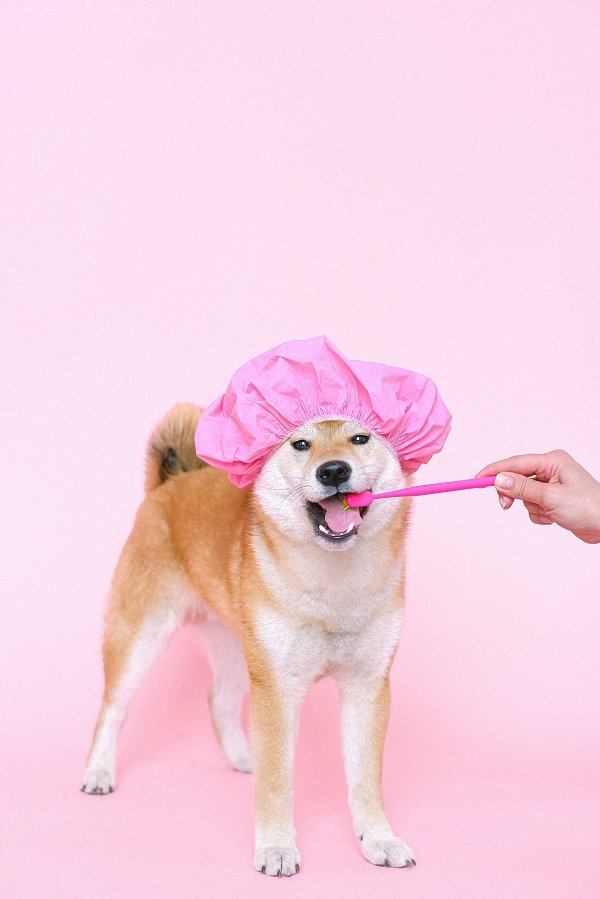GET 15% OFF WITH THE PUPPY BUNDLE
GET 15% OFF WITH THE PUPPY BUNDLE
Shop all

PTSD: Post-teeth-brushing stress disorder - a survival guide
August 03, 2022 4 min read
Let’s face it! Being a pet pawrent is fantastic but… there are certainly moments that no one talks about. Nor do they end up on the gram. Yes, teeth brushing we are looking at you.
Anyone who has ever owned a dog will know that this apparently simple task turns into mission impossible as soon as you grab the toothbrush. Although there are some dogs that don’t mind a daily brush the vast majority will run for the hills as soon as they hear the click of the toothpaste tube. But hey, we don’t judge! If you brush your canine’s canines (like the pun?) on the daily or it’s more of a “when I remember” routine, #youdoyou, whatever works best. After all, the PTSD suffered after teeth brushing is real. Brace yourselves!

How often should you brush your dog’s teeth?
We all know that teeth brushing is an ordeal both for our dogs and our mental health. But, no one likes stinky breath, especially when we all know where our dog’s mouths have been. So gross! According to the American Kennel Club, you should be brushing your dog’s pearly whites every day to maintain optimum oral health. Yet, it is always worth consulting with your veterinarian before making changes to your dog’s health routine. Luckily there are various ways to do this that won’t have you calling your therapist after every brush. Here are our top five tips to make tooth brushing a walk in the park for both you and your pup.
Brush up on your doggy dental facts:
Did you know? Not brushing your dog’s teeth can lead to serious health issues such as:
- Gum inflammation
- Organ disease
- Weight and appetite loss
1. Pick the right tools
To brush or not to brush? That is the question all modern pet pawrents should ask themselves. Today, there are many options for the busy pup pawrent to choose from - some of which involve no brushing at all. From dental chews and teeth wipes to advanced electric toothbrushes, there is something for everyone’s taste and budget. One thing to keep in mind though is quality. Pick only the best for your pooch and you will save on vet bills later on.

2. Choose the right time and place
In an ideal world, dog teeth brushing will be over with the click of your fingers. But, the reality is this daily grooming task can feel as though it lasts a lifetime. Because of that, it is important to pick a time when your dog is at their calmest, with a full belly away from distractions. Make sure that other animals and children are out of the room during teeth brushing to help you maintain your zen master coolness. Then make your chosen area soft and comfortable with cushions and blankets. If your dog is small, wrap them in a blanket and hold them under one arm to brush their teeth. If your dog is larger, sit them on the floor and wrap your arm around their shoulders to restrain them. Never force your dog to stay in a position that makes them uncomfortable, if they move, simply try to settle them once more and begin brushing again.
3. Go for the gums
Since most dogs will run a mile the moment they see the toothbrush, attempt to aim for the gumline. Lift your dog’s lips and instead of trying to prize open their jaws, start brushing the outside of the teeth starting with the ones closest to the front of the mouth. Once your dogs have accepted your efforts, slowly move towards the back of the mouth. This is where you will need to work hardest as it is a breeding ground for plaque. Use small circular movements to brush these teeth.

4. Little and often
To stop teeth brushing from becoming the start of WW3, start with short, quick sessions and slowly increase their duration as your dog becomes more accepting. The key here is patience. It may take a few weeks before you can extend the time but if you get them into a regular routine, it is easier to build up the time you spend brushing.
5. Praise their bravery… and yours!
As the time-honored saying goes, no good deed goes unpunished. And this is certainly how your fur baby will make you feel after you have brushed their teeth. They are unaware that you have sacrificed time, sanity, and nearly your fingers just so that they can have a perfect Hollywood smile. But, they will learn that you do it all because you love them. Reward their bravery each time with their favorite treat, or even better - a dental chew. Treat yourself to something yummy too - it is very much earnt.
Signs you may be suffering PTSD (Post-teeth-brushing stress disorder)
PTSD is a real thing and we are not talking about the medical condition. For pup pawrents, it exclusively relates to the traumatic stress suffered after dog teeth brushing. While symptoms may vary from person to person, the common side effects vary from crippling anxiety at the thought of reaching for the toothbrush to panic attacks when it comes to toothbrushing time. Other reported symptoms include:
- Haunting flashbacks of when your beloved fur baby tried to bite you
- Loss of sleep as you question if you really are a good puppy pawrent
- Overwhelming guilt if you look at what happens if you don’t brush your dog’s teeth
- Over analyzing every look your dog gives you as you begin to think that they hate you after you chased them around the house with a toothbrush.





